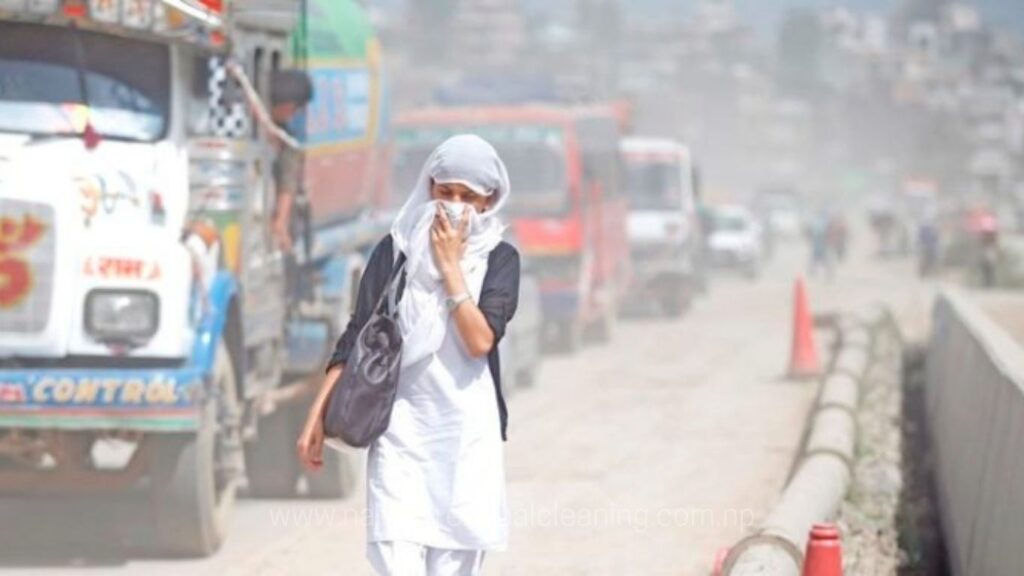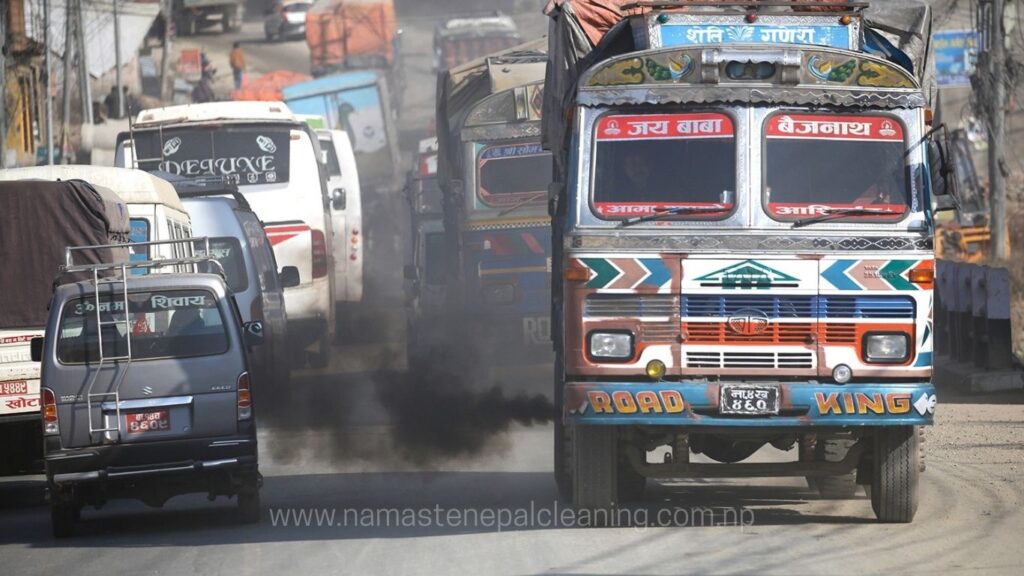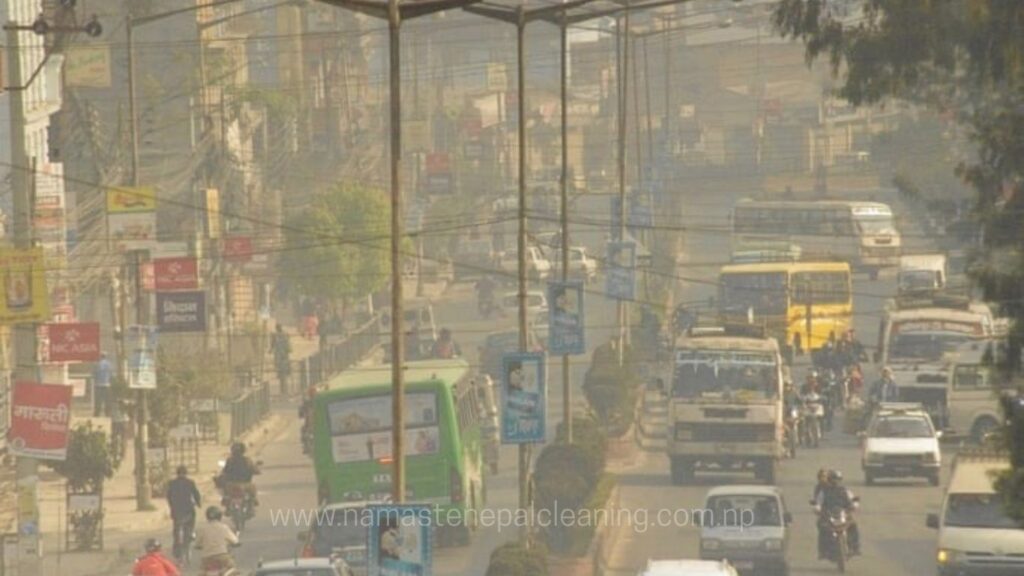Table of Contents
Current Air Quality Status (as of April 2nd, 2025):
The Kathmandu air pollution crisis continues to be a pressing concern. Real-time data indicates that the AQI levels in Nepal, particularly in Kathmandu, remain elevated. For instance, aqicn.org reported a PM2.5 AQI of 197 (Unhealthy) as of late last night, highlighting the severity of PM2.5 levels in Kathmandu. While real-time fluctuations occur, aqi.in currently shows Kathmandu with an AQI around 109-118 (Poor). AccuWeather reports an AQI of 90 (Poor), and Plume Labs indicates 136 (Unhealthy).

What does AQI indicate?
The Air Quality Index (AQI) is a scale used to report daily air quality. It tells you how clean or polluted your air is, and what associated health effects might be a concern for you. The AQI focuses on health effects you may experience within a few hours or days after breathing polluted air. Different countries and regions may use slightly different scales, but generally, the AQI is divided into categories that correspond to different levels of health risk. For example, a common categorization includes:
- Good (0-50): Air quality is considered satisfactory, and air pollution poses little or no risk.
- Moderate (51-100): Air quality is acceptable; however, for some pollutants there may be a moderate health concern for a very small number of people who are unusually sensitive to air pollution.
- Poor (101-150): Members of sensitive groups may experience health effects. The general public is not likely to be affected.
- Unhealthy (151-200): Everyone may begin to experience health effects; members of sensitive groups may experience more serious effects.
- Very Unhealthy (201-300): Health alert: everyone may experience more serious health effects.
- Hazardous (301+): Health warning of emergency conditions: everyone is more likely to be affected.
The consistently high AQI levels in Nepal, especially in Kathmandu, often falling in the “Poor” and “Unhealthy” categories, signify a significant risk to public health due to elevated PM2.5 levels in Kathmandu.
Kathmandu, the vibrant capital city nestled in a bowl-shaped valley, is renowned for its rich cultural heritage and breathtaking Himalayan views. However, beneath the picturesque facade lies a growing concern: the severe Kathmandu air pollution crisis that poses significant threats to public health and the environment. This blog delves into the complexities of Kathmandu’s air pollution, exploring its causes, impacts, responsibilities, and potential solutions involving both citizens and authorities.
The Grim Reality: High Levels of Air Pollution
Kathmandu’s air quality frequently ranks among the worst globally, particularly during the dry winter months. The primary pollutant of concern is Particulate Matter (PM2.5), which consists of fine inhalable particles with a diameter of 2.5 micrometers or less. These tiny particles can penetrate deep into the lungs and bloodstream, leading to a range of health impacts of Kathmandu smog.
Who Bears the Responsibility for This Crisis?

The Kathmandu air pollution crisis is a multifaceted issue with contributions from various sources:
- Vehicular Emissions: The rapid increase in the number of vehicles, many of which are old and poorly maintained, is a major contributor. Traffic congestion further exacerbates the problem, leading to prolonged idling and increased emissions.
- Construction Activities: The booming construction sector in the Kathmandu Valley generates significant amounts of dust and particulate matter. Inadequate dust control measures at construction sites contribute heavily to air pollution.
- Brick Kilns and Industries: Brick kilns operating in and around the Kathmandu Valley often use outdated and polluting technologies, releasing harmful gases and particulate matter into the air. Similarly, emissions from other industries contribute to the overall pollution load.
- Burning of Waste: The practice of burning solid waste in open areas is prevalent in some parts of the city, releasing toxic fumes and particulate matter.
- Transboundary Pollution: While local sources are primary contributors, regional factors and transboundary movement of pollutants from neighboring areas can also influence Kathmandu’s air quality.
- Geography and Meteorology: The bowl-shaped topography of the Kathmandu Valley traps pollutants, especially during stable atmospheric conditions in winter. Inversions can further worsen the situation by preventing the dispersion of pollutants.
- Wildfires and Kathmandu air quality: While not a dominant factor year-round, during certain dry periods, wildfires in the surrounding hills and potentially further afield can significantly contribute to the Kathmandu air pollution crisis by releasing large amounts of smoke and particulate matter into the atmosphere, impacting PM2.5 levels in Kathmandu and exacerbating the health impacts of Kathmandu smog.
The Role of Citizens in Fixing the Issue

While systemic changes are crucial, individual actions by citizens can collectively make a significant difference in addressing the Kathmandu air pollution crisis:
- Promote and Utilize Public Transportation: Opting for public buses, micro-buses, or shared vehicles can reduce the number of private vehicles on the road.
- Embrace Non-Motorized Transport: Walking and cycling for shorter distances not only reduce emissions but also promote a healthier lifestyle.
- Maintain Personal Vehicles: Regularly servicing vehicles ensures they operate efficiently and produce fewer emissions. Consider transitioning to electric vehicles or hybrid options if feasible.
- Reduce Waste and Practice Proper Waste Management: Minimizing waste generation and practicing proper segregation can reduce the need for open burning. Participate in or initiate composting and recycling efforts.
- Support Sustainable Construction Practices: Encourage builders and contractors to adopt dust control measures and more environmentally friendly construction methods.
- Practice Thorough Post-Construction Cleaning: If involved in construction or renovation, ensure thorough post-construction cleaning to remove dust and debris that can contribute to air pollution. Consider engaging professional post construction cleaning services in Kathmandu for effective cleaning.
- Plant Trees and Support Green Initiatives: Trees act as natural air purifiers. Participating in tree-planting campaigns and supporting urban green spaces can help improve air quality.
- Raise Awareness and Advocate for Change: Talk to family, friends, and community members about air pollution and its impacts. Support and participate in advocacy efforts demanding stronger environmental regulations and their effective implementation.
- Use Air Purifiers and Masks: While not a long-term solution, using indoor air purifiers and wearing appropriate masks (like N95 or FFP2) when outdoors can help reduce personal exposure to pollutants, especially for vulnerable individuals given the health impacts of Kathmandu smog.
Government and Authority’s Responsibility for a Breathable Future

Addressing the Kathmandu air pollution crisis requires strong commitment and decisive action from the government and relevant authorities to improve the AQI levels in Nepal:
- Strengthen and Enforce Environmental Regulations: Implement stricter emission standards for vehicles, industries, and brick kilns. Ensure effective monitoring and enforcement of these regulations to control PM2.5 levels in Kathmandu.
- Invest in Public Transportation: Expand and modernize the public transportation system to make it a convenient and attractive alternative to private vehicles. This includes increasing the fleet, improving routes, and ensuring affordability.
- Promote Electric Mobility: Incentivize the adoption of electric vehicles through subsidies, tax breaks, and the development of charging infrastructure.
- Manage Construction Activities Effectively: Implement and strictly enforce regulations for dust control at construction sites. Promote sustainable construction practices.
- Address Waste Management Issues: Develop and implement efficient waste collection, segregation, and disposal systems. Ban open burning of waste and promote environmentally sound waste treatment technologies.
- Invest in Air Quality Monitoring and Research: Expand the network of air quality monitoring stations and invest in research to better understand the sources and impacts of pollution. Make real-time air quality data publicly accessible, including detailed PM2.5 levels in Kathmandu.
- Promote Cleaner Technologies and Fuels: Encourage industries and brick kilns to adopt cleaner technologies and switch to less polluting fuels. Provide financial and technical assistance for this transition.
- Urban Planning and Green Infrastructure: Integrate air quality considerations into urban planning. Develop and maintain green spaces, parks, and tree cover to help mitigate pollution.
- Public Awareness and Education Campaigns: Launch comprehensive public awareness campaigns to educate citizens about the causes and health impacts of Kathmandu smog and encourage their participation in solutions.
- Regional Cooperation: Collaborate with neighboring countries and regional bodies to address transboundary air pollution issues, including those potentially related to wildfires and Kathmandu air quality.
- Healthcare Preparedness: Strengthen the healthcare system to manage the health impacts of Kathmandu smog, including providing information and resources for vulnerable populations.
Conclusion
The Kathmandu air pollution crisis is a complex challenge that demands a concerted effort from all stakeholders. While individual actions by citizens are important, the primary responsibility lies with the government and authorities to implement and enforce effective policies and regulations to improve the AQI levels in Nepal and reduce PM2.5 levels in Kathmandu. By working together, with a shared commitment to a cleaner and healthier environment, Kathmandu can aspire to a future where its residents can breathe freely and enjoy the beauty of their city without the constant threat of air pollution and the associated health impacts of Kathmandu smog.
References
- aqicn.org: https://aqicn.org/city/kathmandu/
- aqi.in: https://www.aqi.in/dashboard/nepal
- AccuWeather: https://www.accuweather.com/en/np/kathmandu/241809/air-quality-index/241809
- Plume Labs: https://air.plumelabs.com/air-quality-in-Kathmandu-5nPq
- Department of Environment, Ministry of Forests and Environment, Government of Nepal

